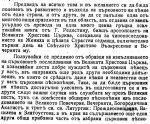Daidalos
Μέλος
Last edited:
Referring to the state of Skopje (F.Y.R.O.M.) as "Macedonia", apart from all others, will lead to the wrong conclusion that supposedly exists a "Macedonian" psaltic school. I read such nonsense somewhere lately…But there was a rural Old Slavonic tradition as well like in Macedonia and Serbia, but these manuscripts have no musical notation. It was an oral tradition which can be followed by fieldwork until the 18th century:
https://independent.academia.edu/OliverGerlach/Teaching-Documents
Αυτό είναι ψαλτική. Μακάρι να ακουστεί κάποτε η σωστή ψαλτική ξανά στην Βουλγαρία και να μη χαθεί εντελώς στην Ελλάδα. Αν συνεχίσει η παρακμή και στην Ελλάδα θα ελλείψει η αρχαία μουσική όπως έχει γίνει σε όλα τα υπόλοιπα Βαλκάνια. Για να μη συνεχιστεί η καταστροφή, εμπιστευτειτε μόνο τα αυτιά σας κι όχι τα θεωρητικά του 20ου αιώνα.
Bulgarian singers also did (and do) not understand certain elxeis which are influenced by an exchange with makam music, especially if they did not share the cultural background of the Phanariotes. But these challenges showed rather productive...



I was...
Or do you believe that psaltic art existed as a rural tradition?
For the particular and also crucial role of monasteries outside Constantinople during the Byzantine past you might have a look at the earlier units (3 and 4). My concept was anti-chronological to begin with the living tradition, and it proved somehow useful...
You might ask, if there is a Bulgarian school of psaltic art? I would rather regard it as a reception, similar to many areas in Greece.
The Rila school widely integrated contemporary composers of the New Music School of the Patriarchate (sometimes with own exegeseis due to the decision to establish Old Church Slavonic as liturgical language), but there were some local compositions as well (made for local needs like the feast of Ioan Rilski, the patron of the monastery) and they contributed with own compositions made over popular models (such as heirmoi kalophonikoi by Petros Bereketis and Balasios the Priest). Nevertheless, they sound very different, since traditional singers in Constantinople stick rather to the trochos system than to the New Method (this is also something which only a few singers in Greece do understand and depending on local schools)! Bulgarian singers also did (and do) not understand certain elxeis which are influenced by an exchange with makam music, especially if they did not share the cultural background of the Phanariotes. But these challenges showed rather productive...
I can only tell you from fieldwork in Bulgaria. Important singers like Otec Stiliyan or Neofit, the current Patriarch, have been highly respected as singers, not only in Bulgaria, but also in Romania and in Greece. Also young singers from Greece came and come to learn from them, like young Bulgarian singers do visit Greece to improve their skills in psaltic art. This attitude is quite common and reveals a reciprocal respect and the need to learn from different schools.
What I meant, when I was talking about the different way of intoning the elxeis, was not that Bulgarian singers did not understand them (they have their own way like any other local school), but I thought of the end of the despotikon (you quoted it here). According to Todorov's edition whose notation is included at youtube, the end was "translated" as a kind of second glas transposed on γα (you will not find it in any Greek edition!). You can listen to the version of different singers here at Analogion, and you will find that some Archon protopsaltes use a kind of sabâ-like intonation in the final cadence on γα. The composition is definitely not by Ioan Kukuzel...
Many say so, but in fact none of my students (neither in Greece nor in Turkey) did recognise Paikopoulos' quotation taken from the opening of the Mevlevi suite (Nâ't-i Mevlana is actually a composition by Buhurizade Mustafa Itrî), while he was performing the tritos cherouvikon.In the Bulgarian chanting tradition, we do not chant Turkish makams. It is forbidden (not literally, but the ear of the Bulgarian people couldn't accept it). It is mostly based on the classical authors and classical pieces.
Thank you very much for this very interesting quotation, I did not know this treatise either and it is very interesting to see, how Turkish makam names had been transliterated into Old Church Slavonic Cyrillic letters!
Very nice, traditional-style chanting indeed, thank you for sharing the recordings of Ivan Kaikov. Please upload more if you have.
